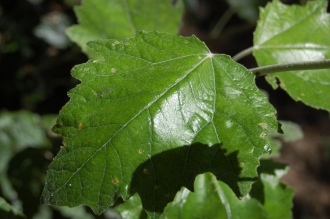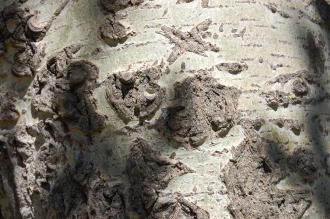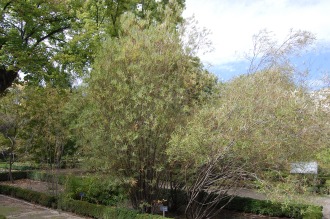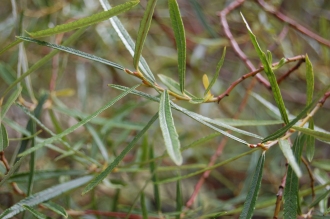Position: Full sun to light shade
Soil: Moist well drained
Flowering period: Spring
Eventual Height: 25m
Eventual Spread: 16m
Hardiness: 4a, 4b, 5a, 5b, 6a, 6b, 7a, 7b, 8a, 8b, 9a
Family: Salicaceae
Populus alba is a fast growing deciduous tree with a rounded habit. Its dark green glossy leaves are five lobed with sinuate margins, up to 15cm long, 10cm broad and with a downy white covering on the underside. Its leaves turn yellow in autumn before they fall. Its white to grey white bark is smooth with diamond shaped marks when young becoming more fissured with age. Its trunk may achieve a diameter of up to 2m. Its flowers are dioecious wind pollinated and appear before its leaves. Its male catkins are up to 8cm long and the female are up to 10cm long. Its fruit are green capsules which contain small seeds that have fine hairs which aids their wind dispersal. Its roots may sucker, particularly if damaged.
Populus alba, commonly known Silver Poplar, White Poplar or Abele, is native to south Europe, central Europe and central Asia. In its native habitat it grows on wet sites, often close to water courses. Due to its suckering roots, this tree may spread given the right conditions and may be invasive. It is considered invasive in many parts of Australia and South Africa.
The etymological root of the binomial name Populus is derived from its ancient Latin name, arbor-populi meaning ‘tree of the people’. Alba is from the Latin meaning ‘white’.
The landscape architect may find Populus alba useful as a fast growing tree with attractive leaves suitable for planting in wet locations. Care should taken when locating this tree as its root may damage drainage systems and foundations. Planting in grass may cause this tree to sucker by damaging shallow roots when mowing. This tree is tolerant of maritime conditions.
Ecologically, Populus alba leaves are attractive to many insects.
Populus alba prefers moist, fertile, well-drained soils. It tolerates most pH of soil. It will tolerate wet soils.
Populus alba requires little maintenance. Suckers of suckering trees may need to be removed annually.
![]()
Landscape Architecture












